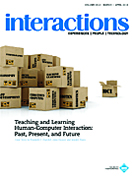Authors:
Jodi Forlizzi
I never intended to be a designer. I wanted to be a famous artist. As an undergraduate art student, I created a series of fake products that did absolutely nothing as a statement of disdain about consumerism in the modern world. But then I experienced a situation of real need, the eye-opening revelation that started my journey as a real designer.
An elderly lady, stooped into a full bow from osteoporosis, often waited for the bus across the street from my apartment. I first noticed her when she cried out for helpthe bus driver would often fail to see that she was waiting for the bus and drive past her. Over the next few months, I got to be friends with Mabel, keeping her company when I spotted her on the corner and helping her flag down the bus. I saw the world and her many frustrations in navigating it through her eyes. I saw her fear and helplessness and experienced it firsthand. I also saw her happiness and pleasure in the simple things like a meal from her church or a day out in the sunshine. I learned how to empathize with her, and I felt it to be imperative that someone create products and services that would give her an easier way to interact with her world. I was ready to step up to the task.
Fast-forward in time. Armed with a freshly minted master's degree in interaction design, I had been formally trained in user research methods to gain a deep understanding of people's spoken and unspoken needs. I joined e-lab, a small company that did user research for new product design. A small group of designers, anthropologists, and social scientists studied the world and the products we use as a performance. We observed people's behavior with snack food, automobiles, shaving products, electricity, chewing gum, and more. We collected and coded data, drawing out perceptions, attitudes, beliefs, and new product opportunities. We placed motion-sensor cameras in people's kitchens, in their bathrooms, and in the aisles of grocery and convenience stores. We did guerrilla research at casinos and convenience stores. We observed people serving donuts and putting salt on fries.
As a project manager, I led teams comprising new staff, veteran staff, and clientssome from other culturesin conducting fieldwork. It was a crazy time. Doing field research was exhilarating. It was fun to go to a family's home, introduce yourself, break the ice, and conduct the interviews and observations that allowed you to snoop on their private lives. Once they trusted you, they would talk, and they often forgot about the cameras.
The work was hard, too. Balancing a mix of expertise, background, gender, and cultural makeup on a team could be exhausting. Teaching about the work and executing the work at the same time was often stressful.
Fast-forward again in time, where, as a faculty member in design and human-computer interaction at CMU, I teach our students to embrace the mantra, "The user is not like me." It's exhilarating to see new students understand, through observation and research, that they cannot rely on their own biases and judgments about others to create better futures for them. Instead, they need to develop a deep empathy for those they seek to understand.
However, empathy is not everything. In design, we need to combine an empathic understanding with action. Here is where the judgments of a designer play a role in deciding how to improve the current state of the individual or group they are struggling to understand. Here is the place where the goals of the redesign sometimes conflict with the goals of an individual designer. In extreme cases, there may be controversy in balancing the needs of those we are designing for, the interests of the client we represent, and the moral and values of ourselves as individuals.
I confess, I believe that not everyone is cut out to be a human-centered designer. It requires empathy, but it also requires more. It is a profession that requires people to be highly visual, intuitive, unbiased, and open to experiencing people. In addition, it requires people to be able to take actions that support the needs of those whose lives they are trying to improve, actions that are potentially not in agreement with their own social or philosophic codes, actions whose effects remain long after developing a new product, service, or environment.
Going beyond empathy is imperative for designers. At its best, our discipline allows people to understand, debate, and acknowledge our differences, but also work for the greater good. Isn't this an imperative for the larger world?
Jodi Forlizzi is an associate professor of design and human-computer interaction at Carnegie Mellon University. She also leads the Human-Systems Interaction Group of the Quality of Life Technology Center, an NSF Engineering Research Center.
©2013 ACM 1072-5220/13/03 $15.00
Permission to make digital or hard copies of all or part of this work for personal or classroom use is granted without fee provided that copies are not made or distributed for profit or commercial advantage and that copies bear this notice and the full citation on the first page. To copy otherwise, to republish, to post on servers or to redistribute to lists, requires prior specific permission and/or a fee.
The Digital Library is published by the Association for Computing Machinery. Copyright © 2013 ACM, Inc.









Post Comment
No Comments Found